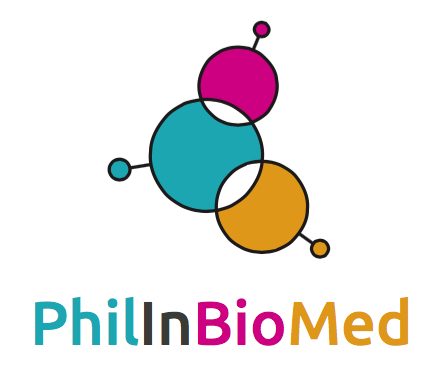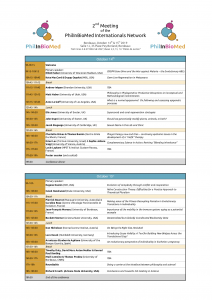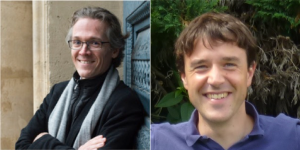
- This event has passed.
Second meeting of the Philosophy in Biology and Medicine (PhilInBioMed) international network (Bordeaux, France)
14 October 2019 - 15 October 2019

PhilInBioMed is both an interdisciplinary institute located at the University of Bordeaux, France, and a national and international network connecting groups and people working at the interface between philosophy, biology, and medicine, with the shared conviction that conceptual and philosophical approaches can make a critical contribution to science and medicine.
After the success of its first meeting, the international PhilInBioMed network has organized this second meeting, that again gathered senior and junior researchers working on conceptual issues located at the interface between philosophy, biology, and medicine.
A great thank you to all the speakers and participants who helped make this meeting a success !
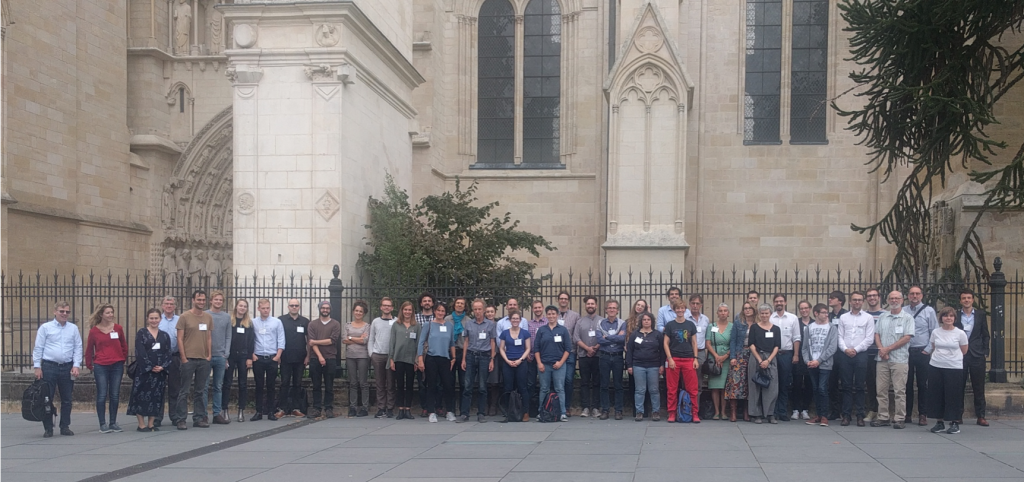
Program and registration
The official Final Program is available by clicking on the image.
Attendance to the meeting is free. Registration is now closed.
Plenary speakers
 Eugene Koonin (Senior Investigator, Evolutionary Genomics, NIH, USA)
Eugene Koonin (Senior Investigator, Evolutionary Genomics, NIH, USA)
Evolution of complexity through conflict and cooperation
Biological systems reach hierarchical complexity that is unmatched outside of biology. New levels of complexity are reached through evolutionary transitions, including Major Transitions in Evolution (MTE). The physical foundation for understanding origins and evolution of complexity apparently can be gleaned at the interface between the theory of frustrated states resulting in pattern formation in glass-like media and the theory of self-organized criticality (SOC). Emergence of complex features in biological evolution typically if not always is triggered by frustration that is caused by competing interactions at different organizational levels. Such competing interactions lead to SOC which precipitates evolutionary transitions.
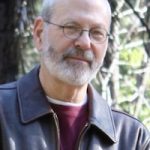 Elliott Sober (Hans Reichenbach Professor and William F. Vilas Research Professor
Elliott Sober (Hans Reichenbach Professor and William F. Vilas Research Professor
in the Philosophy Department at the University of Wisconsin—Madison, USA)
CRISPR Gene Drive and the War against Malaria – the Evolutionary ABCs
CRISPR gene-drives are a new technology for modifying the genomes of organisms so that the inserted novel genes spread rapidly through the population (by violating Mendel’s rules) and are passed down the generations. In this lecture, I’ll explain some basic ideas from evolutionary biology that help one understand their population dynamics: (1) natural selection and the criterion of relative fitness, (2) natural selection for rarity and its effects, (3) evolutionary stable strategies, and (4) the evolution of a driving-gene when it is subject to opposing forces. I then will describe two strategies that are now under development for using CRISPR gene-drive against malaria – extinction (suppression) and modification (substitution).
Invited speakers
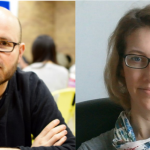 Pierrick Bourrat (Research Fellow,Macquarie University, Department of Philosophy, Sydney, Australia) &
Pierrick Bourrat (Research Fellow,Macquarie University, Department of Philosophy, Sydney, Australia) &
Caroline Rose (Centre d’Ecologie Fonctionnelle et Evolutive, Montpellier, France)
Making sense of the Fitness-Decoupling Paradox in Evolutionary Transitions in Individuality
The nature of biological fitness is one of the most enduring problems in evolutionary biology.[1–5] The term ‘fitness’ features prominently in discussion of evolutionary transitions in individuality (ETIs) – events of major significance in which lower-level entities (particles) interact to form higher-level entities (collectives). Such events encompass evolution of the chromosomes (from genes), the eukaryotic cell (from two bacterial-like ancestors) and multicellularity (from unicellular types). The collectives thus formed become new units in their own right, engaging in the process of evolution by natural as a population of collectives.[6–10]
Although seemingly simple, the idea that selection can shift to encompass new levels of organization is puzzling, especially so given standard approaches to accounting for the transition process [6,11]. Since selection can only occur when there are differences in fitness among units at the focal level of organization,[12,13] it is necessary to invoke a mechanism that is causally responsible for particles becoming members of collectives with which fitness can be associated. One explanation involves the proposal that fitness is transferred from particles to collectives,[7,11] but this view is open to misinterpretation given that transference of fitness is ill-defined and difficult to implement in a model.[8,14]
Data arising from experimental studies of the evolutionary transition from cells to multicellular individuals using microbes[9,15,16] provides some understanding. In one experiment populations of the bacterium Pseudomonas fluorescens were propagated through a selective regime involving a lifecycle comprised of soma- and germ-like phases and where the nascent organisms participated directly in the process of evolution by natural selection. At the beginning of a transition, collectives with low fitness were composed of particles whose fitness was little different to the fitness of the ancestral type. Continued lineage selection led to the evolution of collectives with improved fitness (relative to ancestral collectives), but being composed of particles with reduced fitness relative to the ancestral cell type as determined by measures such as growth rate and population density.[16] Thus, as the transition progressed a decoupling might be said to have occurred between the fitness of the collective and that of its particles. How can the fitnesses of two entities, which are made of the same substrate – the collectives are made of particles – have different evolutionary goals? There seems to be a ‘conflict’ in evolutionary goals at the two levels of organization. In this paper, based on some foundational reasoning about fitness I show that this paradox can be dissolved. Doing so opens new directions of inquiries in this area. More particularly it forces us to focus on the ecological conditions under which ETIs can occur. It is hoped that this approach on fitness will be implemented in an experiment conducted at the Max Planck Institute for evolutionary biology, in collaboration with Professor Paul Rainey.
Literature Cited
[1] L. M. Van Valen, Evolutionary Theory 1989, 9, 1.
[2] S. C. Stearns, Q Rev Biol 1976, 51, 3.
[3] M. Abrams, Frontiers in Genetics 2012, 3, 196.
[4] A. Ariew, R. C. Lewontin, Br J Philos Sci 2004, 55, 347.
[5] F. Bouchard, A. Rosenberg, The British Journal for the Philosophy of Science 2004, 55, 693.
[6] R. E. Michod, Darwinian Dynamics, Princeton University Press, Princeton, 1999.
[7] S. Okasha, Evolution and the Levels of Selection, Clarendon Press ; Oxford University Press, Oxford : Oxford ; New York, 2006.
[8] P. Bourrat, Philosophy & Theory in Biology 2015, 7.
[9] P. B. Rainey, B. Kerr, Bioessays 2010, 32, 872.
[10] B. Calcott, K. Sterelny, Eds. , The Major Transitions in Evolution Revisited, MIT Press, Cambridge, Mass, 2011.
[11] R. E. Michod, Biology and Philosophy 2005, 20, 967.
[12] R. C. Lewontin, Annual Review of Ecology and Systematics 1970, 1, 1.
[13] P. Godfrey-Smith, Darwinian Populations and Natural Selection, Oxford University Press, Oxford ; New York, 2009.
[14] P. Godfrey-Smith, in The Major Transitions in Evolution Revisited (Eds.: B. Calcott, K. Sterelny), MIT Press, Cambridge, MA, 2011.
[15] P. B. Rainey, K. Rainey, Nature 2003, 425, 72.
[16] K. Hammerschmidt, C. J. Rose, B. Kerr, P. B. Rainey, Nature 2014, 515, 75.
John Dupré (Professor of Philosophy of Science, Exeter University, UK) [CANCELLED]
Should we genomically modify plants, animals, or both?
Enthusiasts for high tech food production tell us that feeding the predicted growing human population will require every available technological aid, including genomic modification of food plants and animals. An earlier generation of proposals for GM plants met with a great deal of hostility and in many places was banned, though the reasons for this remain highly controversial. The discussion has been reinvigorated by the development of new, more precise techniques, such as CRISPR-Cas9, and these developments have encouraged much greater interest in the possibility of modifying genomes of farm animals. In this talk I’ll as in what ways these new techniques change the arguments, and how considerations concerning GM animals might differ from those earlier applied to plants. Finally, I will offer some preliminary thoughts about the current status of the ethical debate over genomically modified animals.
Arantzazu Etxeberria Agiriano (Associate Professor, University of the Basque Country, Spain)
An evolutionary perspective of individuality in Eutherian pregnancy
Biological individuals have been traditionally conceived as non-problematic well-bounded entities, inhabiting pre-existing environments and autonomously interacting with other well-defined organisms. In the last years, this tendency has been counterbalanced by reconsidering how individuality is affected by relations of organisms with some biotic others. The aim of this paper is to consider biological individuality from a reproductive perspective according to which biological reproduction establishes some sort of otherness relation within identity. We examine two aspects involved in Eutherian pregnancy as a reproducing relation which (probably) bifurcates into two independent individuals, namely non-pregnant female and newborn. One aspect concerns the role of organism-environment conceptualizations in the case of pregnancy and how to distinguish relations among organisms from relations of organisms with their environments such as in niche construction theory. Different ways of understanding the environment may have crucial implications for how pregnancy as a reproducing relation is conceptualized. The distinction between the embryological and the external environment comes from the insight that environmental interactions with developmental processes are not only essential in the sense that they control crucial developmental parameters, but they can be responsible for fundamental adaptations. The “maternal environment” has been shown to be responsible for essential developmental processes. The second aspect examines the evolution of the relation from a comparative approach that takes into account the similarities and differences in the mother/embryo relationships between close taxa such as eutherians and marsupials. We consider different cases of physiological autonomy, aggregation and integration from a comparative approach that enables the specific understanding of the reproducing relation in eutherians as generating a transient new kind of individual.
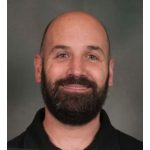 Matt Haber (Associate Professor of Philosophy, University of Utah, USA)
Matt Haber (Associate Professor of Philosophy, University of Utah, USA)
Philosophy in Phylogenetics: Productive Disruptions in Conceptual and Methodological Commitments.
A core methodological and conceptual commitment in phylogenetics has been that a central aim of phylogenetics is to resolve conflicts between competing hypotheses in favor of the best hypothesis (setting aside debates over competing evaluative tools for identifying the best hypothesis). Recently, though, both theoretical and empirical work has challenged this central commitment. I argue that in light of these advances, this central commitment has, effectively, been revised. More specifically, I will argue that phylogeneticists must now also consider whether these conflicts may be reconciled. Though subtle, this revision is highly impactful. In this talk I will (1) provide context for this conceptual challenge; (2) explain the impact of this revision as an expansion of explanatory strategies available to phylogeneticsts; and (3) consider how this case might be generalized as a case of productive disruption that might be applicable to other scientific domains, and identified as an example of scientific progress.
Lucie Laplane (IHPST & Gustave Roussy, France)
PhiLabo: Philosophy “by other means”
A few historians and philosophers of science have performed scientific experiments (mostly consisting in reproducing past experiments) and argued that it provides a unique knowledge of the history of science, of science as a discipline, or of nature itself. Do we need such knowledge in philosophy of biology? There is a tacit historical agreement that philosophy of biology requires some knowledge of biology. However, how much knowledge of the biology is required is unclear, and controversial. It might largely depend on the research objectives. Some questions only require some basic general knowledge of biology (e.g. what is a function?); other requires much more specific and detailed knowledge (e.g. what is a stem cell?). It can also depend on the more general philosophical objectives: philosophy in biology (PinB), because it aims at contributing to biology, might require more knowledge than philosophy of biology (PoB). My aim is to clarify the benefits of getting involved with experimental biology for philosophy in/of biology.
Using concrete examples, I will first develop a weak claim that experimental biology can be useful to philosophy (mostly to PinB but sometime also for PoB), in part thanks to the knowledge it provides, in part for purely methodological reasons. I will then defend a stronger claim that experimentation is necessary to philosophy in/of biology. Sometimes, experimentation is simply necessary for philosophy to move on to the next step. Then, experimentation becomes the natural continuation of philosophy (either PinB or PoB), an integral part of it, “a philosophy by other means” (to return Hasok Chang argument of philosophy as “science by other means”).
Maël Lemoine & Thomas Pradeu (ImmunoConcept, CNRS & University of Bordeaux, France)
Philosophy in Biology and Medicine: Definition and Boundaries
Do philosophers frequently contribute to science, and if so how? Bibliometrics suggests that the influence of philosophy of science on science is far from being negligible, given the number of citations of philosophy of science in scientific journals. Moreover, hundreds of philosophers of science have published in scientific journals – many of them in papers co-authored with scientists – and part of this endeavor has been rewarded with citations, some of which are not just mentions, but either discussions or endorsements by a fraction of the scientific community. In this talk, relying on both a bibliometric approach (in collaboration with specialists) and a focus on the fields we are familiar with as philosophers of biology and medicine, we attempt to characterize how widespread philosophy in science (PinS) is, how successful it has been, what its main tools are, and how it differs from seemingly close approaches. What is it exactly that philosophers may write qua philosophers, that can be considered a contribution to science? Should one be suspicious with such contributions, which might perhaps be deemed not serious science and/or not serious philosophy? Our analysis shows that PinS consists in a mixture of science and philosophy. This mixture is bibliographic, topical and methodological. Scientific references and scientific questions dominate PinS papers, whereas philosophical methods prevail, suggesting that philosophy in science is best described as an attempt to use philosophical tools to answer scientific questions.
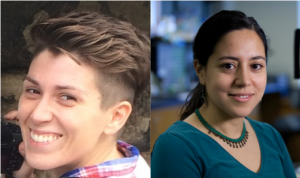 Kate MacCord (Program Administrator and McDonnell Foundation Fellow, MBL, USA) & Duygu Özpolat (Principal Investigator and Hibbit Fellow, MBL, USA)
Kate MacCord (Program Administrator and McDonnell Foundation Fellow, MBL, USA) & Duygu Özpolat (Principal Investigator and Hibbit Fellow, MBL, USA)
Germ Line Regeneration in Metazoans
For nearly 150 years, the distinction between germ cells (the reproductive cells and their progenitors) and somatic cells (the rest of the cells in the body) has been considered inviolable, leading to a dogma along the following lines: germ and soma are discrete cell types and somatic cells cannot differentiate into germ cells. This thinking is, in part, due to the long-held notion that there must be a continuity of the germ line (i.e. information passed from one generation to the next cannot be broken), and has led to the understanding that germ cells, once lost, cannot be replaced. The inability to replace germ cells has been tested and shown continually over the past century by looking at traditional model organisms, such as the fruit fly, nematodes, frog, chicken, and mouse, which cannot replace their germ cells once lost or removed. Despite their inability to regenerate germ cells, research continues on a large scale in traditional model systems, in part because of the immense biomedical relevance of regaining lost reproductive functions.
An increasing amount of recent research in non-traditional model organisms shows that the barrier between germ cells and soma is far more permeable than previously envisioned. Several studies show that a phylogenetically broad range of animals, such as flatworms, fish, Hydra, salamanders, segmented worms, echinoderms, and tunicates not only are capable of regenerating lost germ cells, but sometimes do so by breaking the germ/soma barrier. Regeneration of germ cells can take place at different stages of the life cycle: ablation or removal of germ cell progenitors in the embryo nevertheless result in fertile adults in segmented worms, and sea urchins, while fertile adults can be regenerated from pieces of body lacking any reproductive organs or cells in sea stars, flatworms and segmented worms. The cellular origins and mechanisms for germ cell regeneration also vary across metazoans. While some organisms (e.g. tunicates) use somatic lineages to replace the lost germ cell lineage, others (e.g. flatworms and Hydra) appear to use pluripotent stem cells that can replace both somatic and germ cells, in many other species the cellular mechanisms are still unknown.
Investigations of non-traditional model organisms, drawn from broad swaths of the metazoan clade, are beginning to reveal that the barrier between germ and soma, as well as the regenerative capacity of germ cells, is far from as limited as we have previously understood. These findings lead to many intriguing questions, such as to what extent inheritance of acquired characteristics contributes to evolution where germ cells can be regenerated from soma, and whether new technologies can capitalize on this identity-flexibility to modify generations. Even more pertinent is the question of how some species are capable of these processes while traditional model species (and humans) are not. As we learn more about this phenomenon, we may have to reconsider the dichotomous germ-soma view of the body; one of the most fundamental assumptions in animal biology.
 Jean-François Moreau (CNRS-UMR5164 ImmunoConcept, Bordeaux, France)
Jean-François Moreau (CNRS-UMR5164 ImmunoConcept, Bordeaux, France)
Importance of the mobility in the immune system: aging as a potential example
Although aging seems obvious to all of us, the biological mechanisms underpinning it are yet elusive. More than aiming at an increase in longevity, the question asked merely relies on how to mimic the fate of centenarians in humans, who age but without a series of associated states of diseases such as metabolic diseases, cancer, auto-immunity, brain damages or cardiovascular diseases (collectively called co-morbidities) where in all these situations the immune system plays an important role.
After having briefly described the features of the aging immune system and exposed the believed causes for it, we propose a new mechanistic hypothesis based on the importance of organizing space in biology, including mobility. This organizational 3D view of life on our planet also includes the mobility of the cells comprising the so called "immune system" into a multicellular organism. Using examples from medicine and fundamental research, we would like to suggest that through the unicellular/multicellular transition, the extracellular matrix embedding all cells constituting tissues, organs and metazoans, plays a major role in that spatial organisation. The well-documented modifications of the extracellular matrix correlative of aging should therefore be taken into consideration for explaining the aging process and its co-morbidities.
Dan Nicholson (Fellow at the KLI for Evolution and Cognition Research, Austria)
On Being the Right Size, Revisited
In 1926, Haldane published an essay titled ‘On Being the Right Size’ in which he argued that the size of an organism fundamentally shapes its particular way of life. Size constrains the kind of structure an organism can have, as well as its mode of behaviour. Many of Haldane’s examples are based on the square-cube law, which states that the volume of a body increases much faster than its surface area. The shape of warm-blooded animals, the form of the leaves and roots of plants, and the structure of the pulmonary alveoli and gastrointestinal tract of mammals can all be explained by appealing to this remarkably simple geometric relation. Haldane also showed that the functional capacities of organisms are conditioned by the physical forces that exert the greatest effect at the scale at which they exist. For example, gravity poses no danger to small animals, but the surface tension of water can be a very serious threat to them. The exact opposite is true for large animals.
This talk revives Haldane’s ninety-year-old argument and puts it to work in the context of contemporary molecular biology. Specifically, my claim is that this field would benefit greatly if it took seriously Haldane’s insight that differences in the scale at which entities exist are of overwhelming importance in determining their structure and behaviour. Owing to their minuscule size, cells and their macromolecular components are subject to very different forces than macroscopic organisms. In a sense, macroscopic and microscopic entities inhabit different ‘worlds’: the former is ruled by gravity and inertia, whereas the latter is governed by Brownian motion. This has serious implications for the explanations we formulate. Most crucially, our intuitions—based as they are on our everyday experience of the macroscopic world—fail us when estimating the adaptive problems that cells and molecules have to overcome. The implication is that we should be extremely sceptical of models and analogies that seek to explain properties of microscopic entities by appealing to the properties of macroscopic ones.
Unfortunately, this is precisely what the appeal to mechanical and electronic engineering metaphors in molecular biology attempts to do. Researchers routinely resort to machines because they are familiar and intuitively intelligible. But if our machines were the size of molecules they would not be able to function the way they do, as their physical environment would be completely different. It follows that we should avoid distorting biological reality by construing it in engineering terms. I will illustrate this by examining four key metaphors in molecular biology—‘genetic program’, ‘cellular circuitry’, ‘molecular machine’, and ‘molecular motor’—and showing that their various deficiencies ultimately derive from their neglect of scale.
Finally, I will explain why late twentieth-century biology came to forget the lessons concerning the importance of size and scale that early-twentieth century biologists like Haldane (D’Arcy Thompson is another example) repeatedly drew. I will suggest that the reason has to do with the influence of Schrödinger’s argument in What is Life? (1944) regarding the stability of the gene.
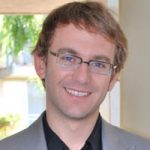 Jacob Stegenga (Reader in Philosophy of Science, Department of History and Philosophy of Science, University of Cambridge)
Jacob Stegenga (Reader in Philosophy of Science, Department of History and Philosophy of Science, University of Cambridge)
Sexual Desire in the Lab and Clinic
There are two competing philosophical conceptions of sexual desire: the appetitive account, which holds that sexual desire is constituted by physiological states directed towards bodily objects and activities, and the intentional account, which holds that sexual desire is constituted by psychological states directed towards reciprocal intentional states. Most of the relevant literature proceeds with hardly any engagement with science—one prominent account asserts that sexual desire “lies beyond the reach” of any science. I propose to turn this around, by investigating how the concept of sexual desire is used in laboratory and clinical settings. What emerges is a hybrid theory of sexual desire, which can respect the compelling arguments for both the appetitive account and the intentional account, and can resolve the shortcomings in both. The hybrid theory is quite simple: sexual desire is both intentional and appetitive. Standard cases of sexual desire involve an appetite for physical pleasure involving contact with another person’s body and are constituted by a rich melange of intentional content. The hybrid theory of sexual desire is supported by a number of arguments, including the fact that it accommodates a range of empirical findings and therapeutic practices, and suggests a compromise between polarised theoretical disputes about sexual desire.
Selected talks
Charlotte Brives (Centre Emile Durkheim, France) & Thomas Bonnin (Centre Emile Durkheim, France)
Phage therapy now and then – continuing epistemic issues in the development of a “misfit” therapy
In this intervention, we discuss phage therapy, the use of bacteriophage viruses to cure bacterial infection. This century-old medical practice has recently been the object of increased attention, as a potential help to fight the increasing prevalence of antimicrobial resistance. We propose to analyze and compare the epistemic obstacles to the development of phage therapy in both periods of widespread interest: the 1920s-1940s initial period of interest about the treatment and the contemporary (1990s-now) renewal of interest in the therapy. In brief, our aim is to see how the failed past attempt to develop phage therapy can inform the ongoing contemporary attempt, and what the continuing issues facing this “misfit therapy” tell us, more generally, about medical practice.
Caleb Hazelwood (Duke University, USA)
Niche Construction Theory: Difficulties for a Practice Approach to Theoretical Pluralism
I formulate criteria for a practice approach to pluralism in evolutionary theory and examine its merits. I use two examples—the evolution of lactose tolerance and starch catalysis in humans—to demonstrate that Niche Construction Theory (NCT) is progressive relative to the Standard Evolutionary Theory (SET) in certain research contexts. However, a difficulty arises for this conclusion: I demonstrate that the expansion of the concept of an evolutionary process is not necessary to accommodate the novel predictions made by advocates of NCT. In fact, the theoretical advancements made by NCT reduce to an explanation in terms of selection—an evolutionary process privileged by the SET. In other words, the standard theory is already equipped to develop the same hypotheses as NCT without having to expand its conceptual boundaries. Thus, as opposed to the practical values of each theory running orthogonal to each other—as one would expect of a pluralistic framework—the hypotheses and predictions motivated by the SET and NCT coalesce. If my analysis is correct, it calls into question whether ‘pluralism’ is warranted in this case, i.e., one in which two competing theories are not genuinely conceptually incompatible. This case study is of particular importance for philosophy biology, as it may promote caution about where and when we impose pluralism on biological thought. It demonstrates the limitations of a practice approach: it is not a panacea for resolving all theoretical debates, as its advocates intend. Furthermore, the debate between these two competing evolutionary theories is riddled with legitimate puzzles — e.g., what kinds of processes are necessary for evolution to proceed — whose solutions are not expounded by a practice approach.
Andrew Inkpen (Brandon University, USA) [CANCELLED]
Health and Ecology
Biological individuals are the paradigmatic bearers of health. They are what philosophers call health subjects: entities that possess the capacity for health and disease. But can entities other than individuals also be health subjects? In this talk, I will discuss cases in which the concepts of health and disease are extended and applied to biological systems other than individuals. In particular, I will consider ecological systems, like communities, holobionts, and ecosystems. I will argue that one currently widespread argument which purports to demonstrate that our concept of health extends beyond the individual fails. From this, I will draw a few implications about what kinds of systems can be health subjects.
Elis Jones (University of Exeter, UK)
Supercorals and coral regeneration strategies
Many scientists have embraced active interventionswith lower evidential thresholdsfor coral regenerationdue to the threats corals face. Approaches target coral biology, ecology or environments, but are contentious. Here, I focus on ‘supercorals’ –corals particularly resilient to anthropogenic threats. The complexity of coral reefs makes them amenable to various interventions prioritising regeneration of different sets of components and functions. I look at how the term supercoral is employed, in the context of different ways coral populations can be regenerated. I highlight the epistemic strategies underlying such efforts, making explicit what coral scientists aretrying to regenerate or preserve in each case. The intended outcomes (e.g. retaining ecosystem services, preserving biodiversity) are highlighted, along with their associated normative commitments. Analysing the strategies and goals of supercoral projects helps in understanding debates around the term supercoral and its associatedtechniques. It also helpsshow contradictory aspects of efforts to save corals, and how compatible they are with other coral regeneration projects. This is particularly important given the multifaceted role of coral reefs (as ecosystems, organisms and environments) and the likelihood that coral reefs will continue to be subject to human interference and modification.
Lara Keuck (Humboldt University, Germany)
Introducing Scope Validity: A Tool for Building New Bridges Across the Translational Gap?
The traditional epistemology of translational medicine adheres to a sequential and separate order. Biomedical researchers first explore candidate targets of intervention in mechanistic animal-based preclinical studies. The results are then extrapolated to humans and tested in randomized controlled clinical trials. A large part of these clinical studies yield negative results. In drug research and development, the difficult step from bench to bedside has been called the ‘valley of death’ or ‘translational gap’. In my talk, I take a closer look at one source of this gap: the mismatch between what qualifies as disease within different areas of research and application—from animal models to general health care. Drawing on examples where this problem is particularly evident, I introduce ‘scope validity’ as a conceptual tool to connect various local measures of validity in a way that makes divergences in identifying a disease transparent. This meta-perspective shall serve to collect, compare, bring into dialogue, and refine existing practices of validation that challenge the traditional sequential order of translational medicine. I will discuss how my interactions with biomedical scientists have informed this project so far and the challenges and possibilities to create impact.
Anne Le Goff (University of Los Angeles, USA)
What is a normal epigenome? On following and assessing epigenetic processes
The NIH Roadmap Epigenomics Mapping Consortium has set as its aim to “deliver a collection of normal epigenomes” that would serve as a reference point. Yet, epigenetic states are inherently plastic, evolving across the individual life span and according to different environmental contexts. We argue that epigenetic entities should rather be conceived as processes, with change rather than stasis being their default mode of existence. How should normality be defined for such processes? Can a normal form of an epigenetic process be experimentally defined in a way that would be actionable in dealing with pathologies? In order to answer these questions, we focus on a case of toxicoepigenetics as a clear example of a strategy to identify and characterize abnormal epigenetic changes induced by a chemical exposure. We examine how these changes in epigenetic processes are experimentally identified and quantified over time and conceptualized. Understanding their processuality is paramount to understanding their effects both for basic science and clinical applications.
Itamar Lev (Tel Aviv University, Israel) & Sophie Juliane Veigl (University of Vienna, Austria)
Complementary Science in Action: Reviving “Blending Inheritance”
Scientific pluralism has gained a prominent status in the philosophy of science. Several normative scientific pluralists argue that in order to expand our knowledge, a plurality of theories, explanations and methods should be introduced into science. One way of doing so is by engaging in “complementary science” – reintroducing theories, concepts or whole “systems of practice” which were once rejected. While such an endeavour sounds promising in theory, we will put “complementary science” to the test. As a molecular biologist and a philosopher of science joining forces, we aim at showing how “philosophy in science” can be realized as a collaborative approach. We will use “blending inheritance” as a case study and we will ask whether this concept should be reintroduced to describe phenomena pertaining to the inheritance of acquired traits. In so doing we will examine the promises, but also possible challenges of complementary science and, in the long run, scientific pluralism.
Beckett Sterner (Arizona State University, USA)
Decentralized but Globally Coordinated Biodiversity Data
We argue for a novel philosophy of biodiversity data science that embodies the spirit of the Web as “small pieces loosely joined” in a decentralized but global approach to coordinating data across scientific languages (Weinberger 2002). Our approach enables data synthesis without presupposing unification as a necessary starting or ending point for science, although it is consistent with both (Mitchell 2002, Leonelli 2013). In contrast, dominant paradigms for data discovery and integration in biomedicine presuppose stable consensus among multiple scientific communities about the best way to classify natural phenomena (Smith et al. 2007, Smith 2008). Following this model, first-generation big biodiversity data projects have prioritized scale and comprehensiveness at the price of imposing uniformity on data that were generated using different standards and classification schemes. Next-generation solutions, however, must now reckon with the limitations of overriding local differences in the production and meaningfulness of data (Franz and Sterner 2018, Hoburn et al. 2019).
Selected posters
Luciele Bokobza
José Borghans
Sara Coelho & Achim Stephan
Luciana Garbayo
Gregor Greslehner
Nace Kranjc and Borut Trpin
Robert Meunier & Saliha Bayir
Pierre Savagner
Mark Tonelli
Call for contributions
The organizing committee welcomes abstracts for 30 minute oral presentations (20 minutes + 10 for discussion) on any subject combining biological or medical science with a conceptual or philosophical approach in such a way that the resulting paper makes an important contribution from both a scientific and a philosophical point of view.
Abstracts must be submitted to Lucie Laplane by May 30th, 2019.
Notifications will be sent on June 21st at the latest.
The submission must contain:
– Name(s) of author(s)
– Institutional affiliations & position
– Title of the talk
– Abstract: no longer than 500 words. The abstract must show as clearly as possible how the talk can contribute to both philosophy and biology / medicine.
Funding
Stipends to attend the meeting will be awarded to up to 10 students or young researchers (Master or PhD students, or postdoctoral researchers), based on the quality of the proposal (amount: between €500 and €1,000 each).
Publication
The best contributions will be submitted to a leading journal as a special issue, edited by Lucie Laplane, Maël Lemoine, and Thomas Pradeu.
Scientific committee
Hasok Chang (University of Cambridge, UK)
Richard Creath (Arizona State University)
Paul Griffiths (University of Sydney)
Matt Haber (University of Utah)
Lucie Laplane (IHPST & Institut Gustave Roussy, France)
Maël Lemoine (ImmunoConcept, University of Bordeaux, France)
Sabina Leonelli (University of Exeter, UK)
Tim Lewens (University of Cambridge, UK)
Kate MacCord (Marine Biological Laboratory, USA)
Jane Maienschein (Arizona State University & Marine Biological Laboratory, USA)
Jean-François Moreau (ImmunoConcept, University of Bordeaux, France)
Alvaro Moreno (University of the Basque Country, San Sebastian, Spain)
Thomas Pradeu (ImmunoConcept, CNRS & University of Bordeaux, France)
Isabella Sarto-Jackson (KLI, Klosterneuburg, Austria)
Organizing committee
- Wiebke Bretting (CNRS, Bordeaux, France)
- Lucie Laplane (IHPST & Institut Gustave Roussy, France)
- Maël Lemoine (University of Bordeaux, France)
-
Thomas Pradeu (CNRS & University of Bordeaux, France)
Registration and cost
Attendance to the meeting is free. Registration is mandatory: plese register here
Lunches and coffee breaks will be covered. The conference dinner will also be covered for all speakers.
More on the PhilInBioMed international network
The groups that constitute the PhilInBioMed international network are: ImmunoConcept in Bordeaux, France; Arizona State University; the History and Philosophy of Science Project at the Marine Biological Laboratory in Woods Hole; the Theory and Method in Biosciences group at the University of Sydney; Egenis at the University of Exeter; the Department of History and Philosophy of Science at the University of Cambridge; the IAS Research Centre for Life, Mind and Society at the University of San Sebastian; the Konrad Lorenz Institute; and the Philosophy of Biology Group at the Department of Philosophy, University of Utah, the Department of Philosophy at the University of Cincinnati and the Department of History and Philosophy of Science at the University of Pittsburgh.
